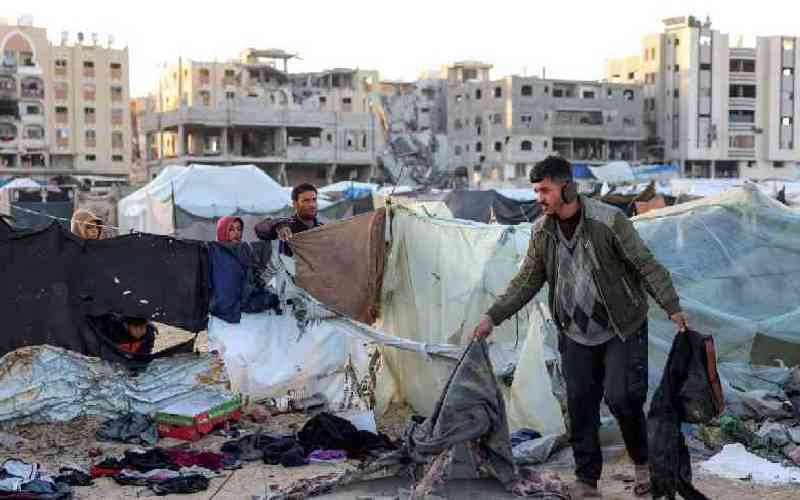By Amos Kareithi
in Caesarea, Israel
The giant marble pillars still stand erect, facing the blue ocean waters gently lapping on the seashores, like disciplined soldiers waiting for their King.
This is the architecture of biblical King Herod, not recorded in the Bible, but is part of a history that Christians the world over will revel in again as they embrace the Christmas festival.
 |
The floor and part of the public bath house Herod built. It is still intact more than 2,000 years on. |
The story is well known how Herod ordered the killing of baby Jesus and Jewish male infants. But few Christians who commemorate Christmas will ever see this highly regarded legacy of Herod.
The walls of one his palaces, which once surrounded the majestic walkways, have since crumbled, but the pillars have withstood the sands of time.
Herod’s handiwork and ingenuity in construction is manifest in extreme detail preserved for tourists to savour.
Very few people will attach positive things to Herod, given that he demonstrated his desire to expunge Christianity when Jesus was born more 2,000 years ago in Nazareth.
What with tales of Herod’s phobia of conspiracy that saw him kill his own children and wife, fearing that enemies seeking to oust him would use them. He had also earlier executed Jesus’ harbinger John the Baptist.
The king was so paranoid that he also ordered the killing of his brother-in-law.
But despite his weakness, the great king had a taste of good life and spared no effort to ensure that his subjects enjoyed life to the fullest.
To keep his subjects from grumbling about his misrule, Herod built a theatre and arena for horses to entertain them.
Overlooking the scenic beach stands some of the collapsed walls that once supported the arena complete with the seats.
A dais was constructed to enable the king watch the races uninterrupted, at the point where the horses turned.
Stay informed. Subscribe to our newsletter
"But the king and his court were bored. Cages were constructed where wild animals were unleashed on people and as they fought for their lives, crowds cheered," explains a curator, Zivil Sari.
Public bathroom
The ruins show how the super rich lived during the Roman Empire, in pleasure which can measure up to today’s luxuries.
In a public bathroom, whose floor has miraculously survived the vagaries of weather and natural erosion for two centuries, the marble and tiles look as if they were constructed recently.
The breathtaking but intricate mosaic patterns are startlingly without blemish, belying the many bloody battles and vagaries of the weather for 2,000 years.
To make the bathroom functional, Herod instructed his subjects to construct tunnels, which supplied water to the beach, which had no clean supply.
"Herod was a genius. He used force of gravity to supply water not only to Caesarea, his city, but also to Jerusalem constructed on mountains," says Sari.
Caesarea, had a population of 10,000 residents who were treated to blood shows as slaves were dragged out of cells and fed to crocodiles and a tiger.
"Excavators have discovered cells and cages next to the arena where slaves and animals used for entertainment were kept," Sari says.
But the masterpiece of Herod’s architecture is the 3,500 capacity amphitheatre, which was built behind the arena.
The open, unroofed semi-circular building which resembles a soccer stadium, is still intact with its stone benches.
"The acoustics of the amphitheatre is so fantastic that we still use it today. The floors are as they were during Herod’s time. If he were to resurrect today, he would recognise it; nothing has changed," Sari says.
A stone’s throw away an investor is cashing on the ingenuity of Herod. A restaurant, King Herod’s Dream, has been put up and offers a perfect view of the ruins.
The Holy City
Less than 20 metres away, another tourist spot, The Crusader’s Restaurant, overlooks Herod’s ruined palace offering guests the best of the view of the beach.
Caesarea cannot rival the beauty and importance of Jerusalem, the holy city for Christians, Jews and Muslims.
Apart from the ancient and Biblical cities, Israel has some ultra-modern buildings.
The country’s cities are quite different from our own in many aspects.
A Nairobi resident straight from Muthurwa Estate would be confounded to drive on a highway near the City of Nathania.
Muthurwa is a madhouse where tenants put up with the cacophony of the public bus park, which is operational all day and part of the night. In Israel, when a busy highway snakes past a residential estate, its tenants are protected from the endless noise.
"The glass walls are very good for acoustic. They minimise the noise. Where there are no glass walls, some concrete ones are erected," Sari our guide explains.
The Bible records that the King Herod ordered the killing of all boy infants during the period so as to eliminate Jesus after he was tipped by the three wise men about the his birth.
Herod the Great and his son died thousands of years ago but their dream still lives on and has continued to baffle pilgrims in Israel.
Although Arabs, who at one time dominated Israel in the medieval times, destroyed Herod’s city, some of its buildings and walls still stand today.
 The Standard Group Plc is a
multi-media organization with investments in media platforms spanning newspaper
print operations, television, radio broadcasting, digital and online services. The
Standard Group is recognized as a leading multi-media house in Kenya with a key
influence in matters of national and international interest.
The Standard Group Plc is a
multi-media organization with investments in media platforms spanning newspaper
print operations, television, radio broadcasting, digital and online services. The
Standard Group is recognized as a leading multi-media house in Kenya with a key
influence in matters of national and international interest.
 The Standard Group Plc is a
multi-media organization with investments in media platforms spanning newspaper
print operations, television, radio broadcasting, digital and online services. The
Standard Group is recognized as a leading multi-media house in Kenya with a key
influence in matters of national and international interest.
The Standard Group Plc is a
multi-media organization with investments in media platforms spanning newspaper
print operations, television, radio broadcasting, digital and online services. The
Standard Group is recognized as a leading multi-media house in Kenya with a key
influence in matters of national and international interest.









